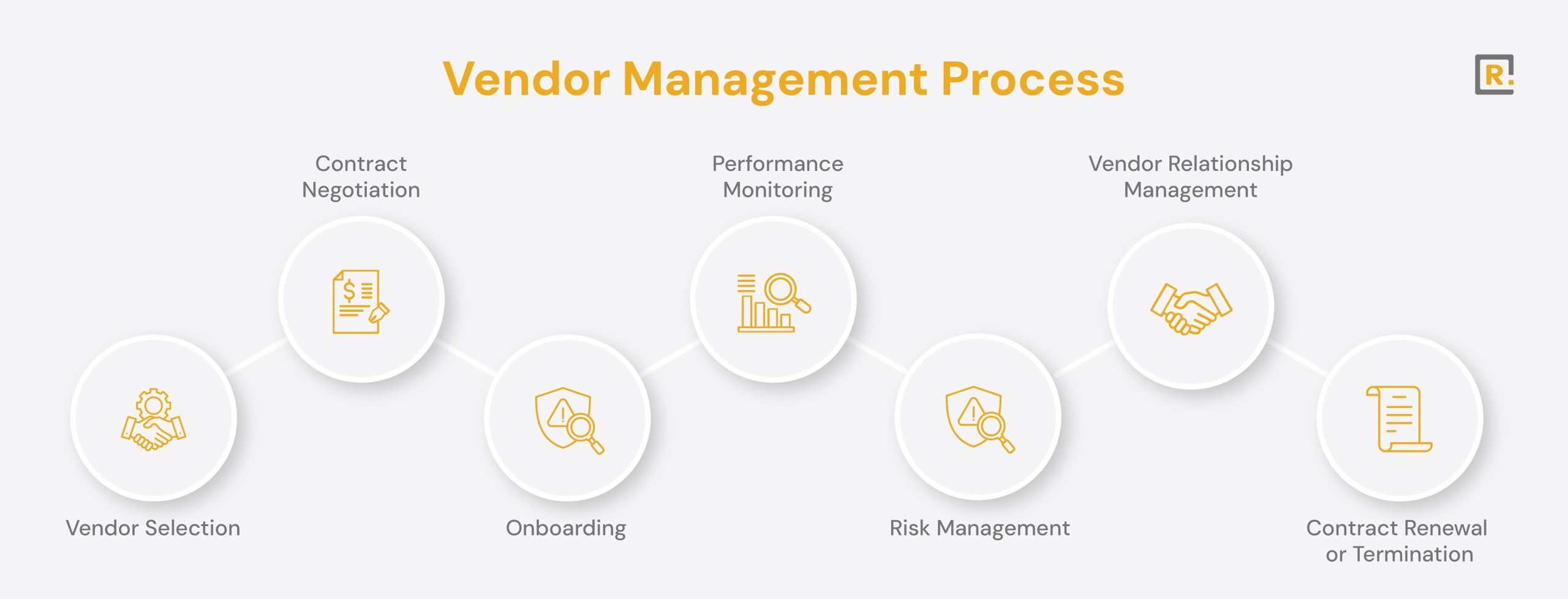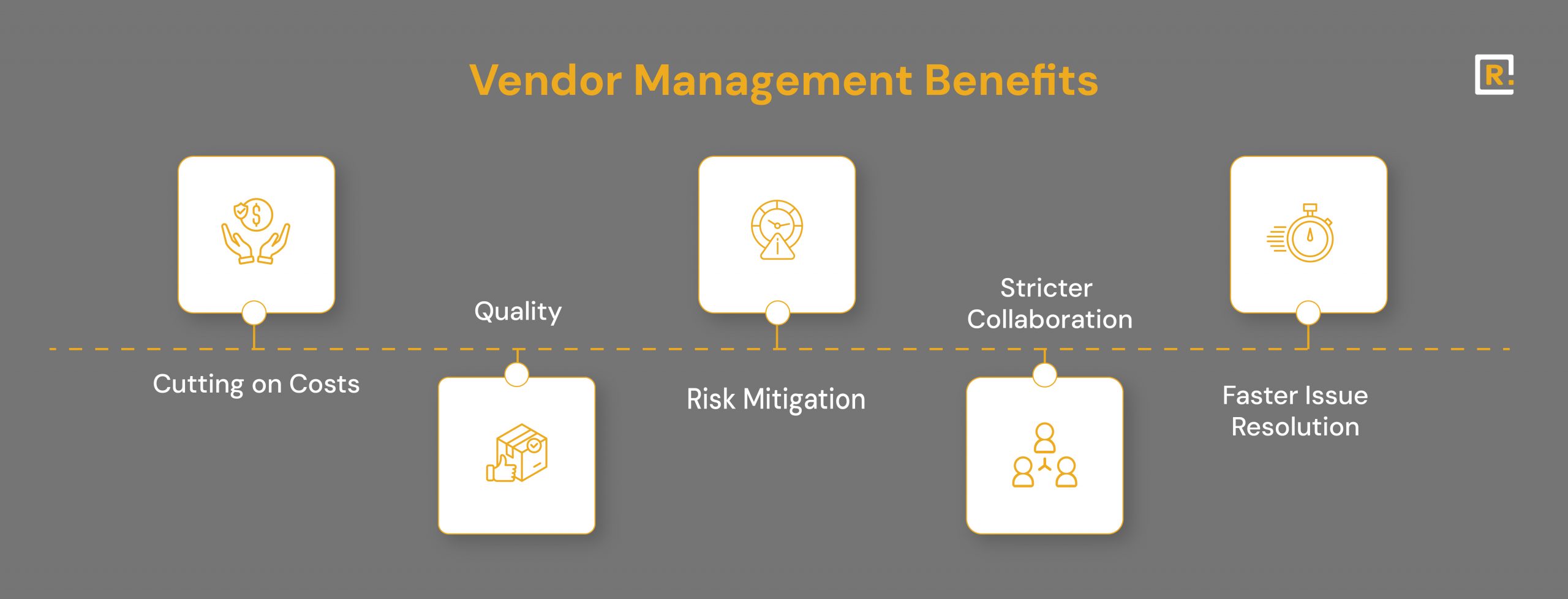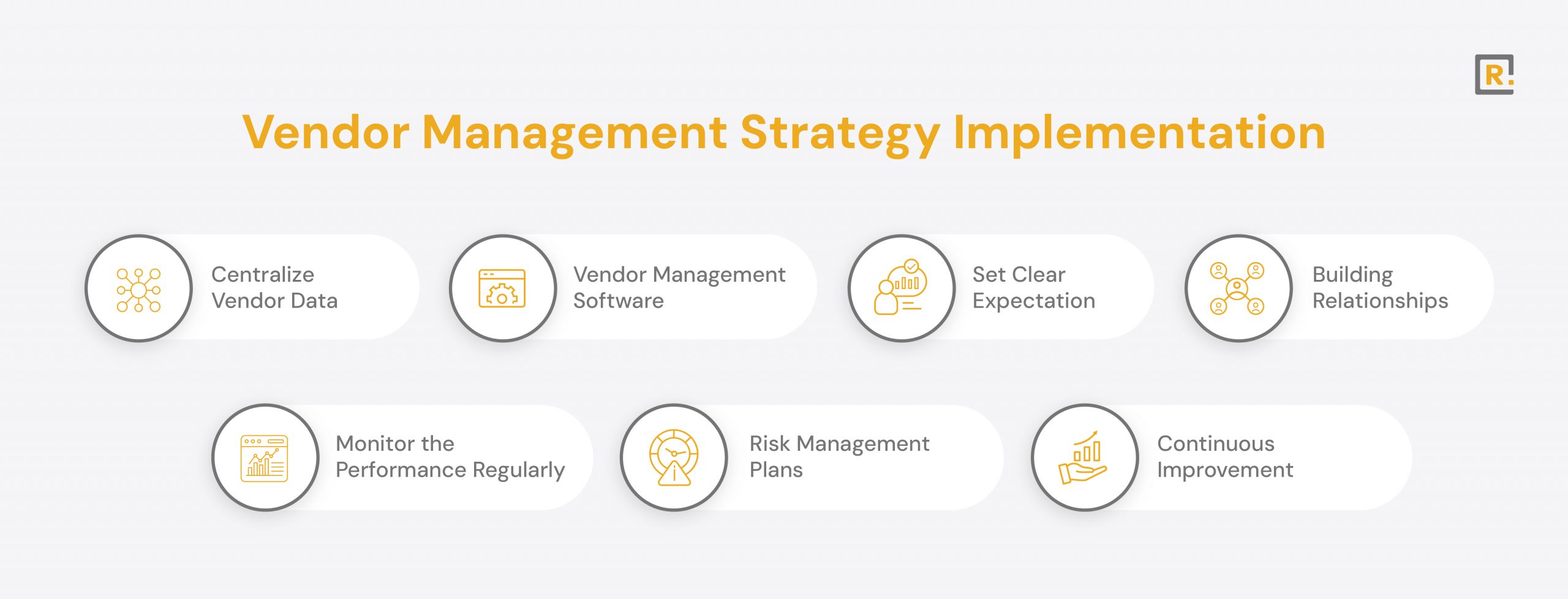-
Solutions
Vendor Management Efficient vendor management platformField Service Management Effective onsite service operationsReal Estate Management Efficient real estate managementAsset Management Efficient asset lifecycle managementDistribution Management System Optimized supply chain distributionDigital Retail Solution Integrated e-commerce solutionsSubscription and Billing System Automated billing and subscriptionsSales Force Automation Optimized sales process automationIntelligent Character Recognition Software Automated text conversion and data extraction
- Why Raapyd
- Resources
- About
Vendor Management in Procurement: Step-by-Step Guide

The stiff competition in modern businesses today promotes a greater need for efficient procurement.
Wonder why?
This is because vendor management is an essential facet of procurement success. This structured program manages suppliers and improves vendor deliverables, creating long-term, mutually helpful relationships with the supplier.
Additionally, focus on vendor management in procurement can help firms improve cost savings quality improvements on goods and services, mitigate risks, and enhance competitiveness.
Therefore, in this blog, we examine procurement in more detail to understand its entails, the process involved, and some benefits businesses can leverage with proactive vendor management.
So, continue reading as we learn more about vendor management and how evolving solutions like Raapyd can change how it works with its automation tools.
What is Procurement?
Simply put, ‘procurement’ is obtaining or buying the goods and services a company needs to run its activities. However, procurement goes beyond purchasing. t could be broadly defined as selecting vendors, negotiating contracts, issuing purchase orders, and ensuring regulatory and legal compliance.
There are usually two types of procurement:
- Direct Procurement: This refers to purchasing goods and services directly involved in production. Examples are manufacturing raw materials, components, and parts.
- Indirect Procurement: This involves purchasing goods and services that are not directly incorporated into the business’s final product but into its operations. Examples include office supplies, software, and outsourced marketing services.
After all, procurement is a strategic corporate function that helps businesses acquire their resources at the right time, price, and quality. Paying for the maximum value creation on the resources procured must be balanced by the minimum risk.
A well-designed process for vendor management in procurement can positively impact any organization’s bottom line, improve operational efficiency, and enhance product quality.
The Process of Vendor Management
Vendor management manages a company’s external suppliers, from vendor selection to performance evaluation. Interestingly, nearly 85% of companies find achieving their procurement sustainability goals challenging when they don’t follow the different steps involved in the management process.
Several steps ensure that the organization and its vendors communicate with and collaborate.
Outlined below are the steps for the vendor management process:
Step 1: Vendor Selection
Vendor selection is the first step in vendor management. This is where potential vendors are identified and evaluated for their ability to meet the company’s needs, and terms are negotiated. The primary selection criteria frequently used comprise of:
- Price: The company guarantees that the cost will not be a problem; hence, one will receive value for money.
- Quality: High-quality products and services are part of what is supposed to be considered; therefore, the vendor’s availability is also essential.
- Reputation: An overview of the vendor’s history regarding reliability and customer satisfaction.
- Scalability: Can the vendor scale higher or lower according to the firm’s needs?
Lastly, every company should ensure that the vendor complies with all industry regulations and legal standards.
Step 2: Contract Negotiation
Once there is an agreed-upon vendor, the next step in the process is contract negotiation. This process stage allows both parties to agree on terms, prices, delivery timelines, and performance standards. At a high level, a summary of key aspects that should be in a contract includes:
- Deliverables: Clearly defined deliverables to be presented with goods and services.
- Pricing structure: Elaborate cost structure, mentioning the discounts against different exposures, marling, and penalties for late delivery.
- Service Level Agreements (SLAs) – The criteria against which the vendor provides the service.
- Termination clauses: Conditions under which the contract can be terminated.
Step 3: Onboarding
Onboarding is the integration of the vendor into company dealings. This is achieved through training, the definition of the communication schema, and the setup of related systems required to monitor vendor performance.
Onboarding is also intended to establish the vendor’s understanding of roles and responsibilities and the company’s alignment of objectives.
Step 4: Performance Management
Good vendor performance management ensures that the vendors deliver what was promised. It is done through the routine measurement of key performance indicators such as:
- Delivery times: are goods and services delivered as scheduled?
- Quality: conform to the laid down levels of quality?
- Cost control: are the controls regarding costs enough within the agreed limits?
- Responsiveness: how responsive is the vendor to problems or requests?
Regular performance reviews allow for easier highlighting of areas that need improvement; in this way, companies can sort out problems before they escalate into significant issues during the vendor procurement process.
Step 5: Risk Management
Another critical area in vendor management is proactively managing all the risks associated with vendor relationships. This involves identifying stipulated risks, including supply chain disruptions, regulatory violations, and financial instability.
It is further followed by executing strategies poised to mitigate these risks. For this reason, a good risk management strategy ensures that companies have a contingent plan in a scenario where the vendor may fail.
Step 6: Vendor Relationship Management
Human relations with vendors enable greater and better collaboration, providing the scope to grow about what can be achieved best. This collaboration comes from open and honest communication, transparency, and a long-term partnership approach, not a short-term transaction approach.
Step 7: Contract Renewal or Termination
A company can renew or end a contract when it ends for reasons such as vendor performance, a change in business needs, or the potential to gain better terms.
Companies may want to renew the terms for better pricing or service levels. On the other hand, terminating will undoubtedly contribute to a better-disrupted exit strategy.
Benefits of Proactive Vendor Management
Effective vendor management offers myriad benefits to businesses. A firm can reap many benefits by strengthening its bonds with vendors and monitoring their performance.
Let’s have a look at some unique benefits of vendor management in your operations:
Cutting on Costs
Through proactive vendor management, companies are empowered to negotiate better terms and identify opportunities for cost savings, such as discounts on bulk purchasing, re-negotiated contracts, or other enhanced payment terms. All these gradually add up over time and start contributing to increased profitability.
Quality
Companies can always mitigate the risks involved in dealing with vendors who either tend to supply defective goods or offer subpar services. This can quickly be done by closely monitoring the vendors’ performance and having explicit expectations.
Risk Mitigation
Proactive vendor management means identifying potential risks early and taking relevant mitigating actions. Whether diversifying the supplier base or developing contingency plans, managing risks helps ensure that businesses are always aware of vendor failures or disruptions.
Stricter Collaboration
This cooperation or sharing of the vendor burden from businesses allows innovation. Vendors who feel valued are more likely to propose new solutions, share insights and industry knowledge, and work together to solve problems toward mutual success.
Faster Issue Resolution
Open lines of communication with the vendor address immediate issues and maintain a performance trail. Again, this becomes instrumental in reducing delays and disruptions and ensuring smooth operations.
Why Should You Focus On Vendor Management?
The complexities in today’s business world increase the importance of why businesses have to focus on vendor management. Here are a few reasons why a business should focus on making vendor management a clear priority:
- Access to Global Supply Chains: As companies expand and expand their tentacles worldwide, supply chains are broadening and becoming complex, with vendors from countries, industries, and regulatory environments.
It is then essential that vendor management becomes effective in that all vendors, irrespective of geographies, bring value uniformly and conform to company standards.
- Regulatory Compliance: Most industries are highly regulated, and ensuring compliance can be challenging when managed across a network of vendors. A strong strategy for vendor management averts vendor violations of industry regulations, reducing the possibility of fines and litigation against the company.
- Supply Chain Disruptions: Disruptions such as natural disasters, geopolitical turmoil, or pandemics can also seriously affect supply chains. Proper vendor management can help companies recognize alternative suppliers, diversify the vendor base, and design contingency plans to reduce disruptions.
- Competitive Advantage: Businesses with efficient vendor management reap competitive advantages in terms of better products and services offered to the market, which enables them to outperform their competition.
Challenges Faced in Vendor Management
Even with vendor management’s many advantages, there are still numerous challenges associated with the software. Understanding these challenges is the first step in solving them.
Lacks Transparency
One of the major concerns is the need for more transparency in the supply chain. In this area, it is especially difficult to create effectiveness without visibility of vendor operations for companies to assess risks, track performance, or ensure compliance.
Communication Barriers
In particular, when supply chains are global, somewhat poorer communication can result due to time zones, different languages, and cultural discrepancies. This can all lead to delays, misaligned expectations, and missed collaboration opportunities.
Complex Vendor Ecosystem
Growing businesses typically equate to more extensive vendor networks. These networks can become unmanageable across multiple regions or industries, and some organizations have many contracts with one vendor.
Performance Monitoring
Vendor performance can be tracked across multiple contracts and projects, though it takes a lot of work. This requires KPI tracking, delivery schedules, and compliance levels—all of which can be prone to human errors and omissions, resulting in no opportunity for improvement.
Risk Management
Identification and mitigation of risks related to vendor relationships require proactiveness. Without a strategy dedicated to the cause, companies usually miss early signs—usually late notifications—of vendor issues, which ultimately cause costly disruptions.
Once you address these challenges in vendor management, it’s a matter of time until you see the results in your operations.
Implementing a Vendor Management Strategy
To address the challenges mentioned above, businesses need to have a sound vendor management strategy in place. Here is how to go about it:
1. Centralize Vendor Data
Now, the availability of all vendor information, including vendor contracts and performance, in one place aids organizations in quantifying their vendors. It helps businesses gain more visibility and be better positioned to quickly review a vendor’s performance, compliance with vendors, and the risks that come with them.
2. Vendor Management Software
Automating much of the manual work done in vendor management can justify investments in vendor management software. Such tools can keep track of contracts, monitor performance, maintain payment records, and ensure the best compliance is reached. Automation frees up time for procurement teams to focus on strategic activities.
3. Set Clear Expectations
Clearly define performance metrics, delivery timelines, and quality standards for each vendor. Establish service level agreements (SLAs) that define what is expected and the implications of not doing so. This way, vendors know what they are being held accountable for.
4. Building Relationships
Each chief vendor will aim to build long-term partners or allies. Invest in ongoing interaction and be constructive with feedback, looking for ways to give these people a say in sharing in your success. Strong relationships with vendors allow them to perform, which leads to shared success.
5. Monitor the Performance Regularly
Monitor the vendor’s performance against the agreed-upon KPIs and ensure that issues are handled appropriately. Constant performance reviews keep vendors in the lane, sometimes identifying areas for improvement.
6. Risk Management Plans
Develop vendor-specific Risk Management plans. Be sensitive to common potential risks like supply chain interruptions or breaches of legislative provisions and implement contingency plans. Ensure diversification of the vendor base so that no vendor has to increase dependency on any single supplier.
7. Continuous Improvement
Vendor management doesn’t take place just once; it is a continuous process. You must constantly evaluate your relationships with vendors, fine-tune your strategies, and consider ways collaboration, performance, and savings can be improved.
Transform Your Vendor Management with Raapyd
Raapyd’s innovation in vendor automation tools has made it a frontier for all businesses, saving time, trimming costs, and boosting relationships with other vendors.
All Your Vendors on One Platform
Raapyd provides businesses with one central platform to handle vendors, contracts, and transactions. It enhances visibility and ensures that nothing slips through the cracks.
Automated Payments
The automation tool it has taken from Raapyd ensures that vendors are paid on time, avoiding the risk of late fees. This helps maintain robust relationships and smooth operations.
Performance Tracking
Raapyd’s platform makes it easy to track vendor performance in real-time. Companies can monitor KPIs, delivery schedules, and quality standards to ensure vendors meet their obligations.
Risk Management
Raapyd’s platform includes tools for tracking compliance and managing vendor risks. Businesses can stay on top of regulatory requirements and address potential risks before they become problems.
Scalable Solutions
As businesses expand, Raapyd’s solutions can scale. It is designed to scale vendor networks and the associated complexity, ensuring innovative management of the vendors as they continue to grow effectively and efficiently.
Conclusion
Vendor management remains the most critical procurement element, and companies that have benefited from it have a tremendous competitive advantage. Strong, collaborative relationships that help firms succeed can only be achieved by choosing the right vendors, setting explicit expectations, monitoring performance, and managing the risk associated with this strategic alliance.
Proactive vendor management saves money, enhances quality, reduces risks, and increases collaboration. Since managing vendors is quite a challenge, a well-understood strategy and automation tools, such as Raapyd, need to be utilized to simplify the process. Optimized vendor management will be a key business capability for operational excellence and growth as businesses adapt to change.
Discover More
Enhance Your Vendor Procurement Process
Unlock the full potential of vendor management with Raapyd’s cutting-edge solutions.



